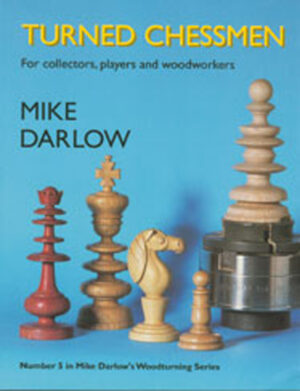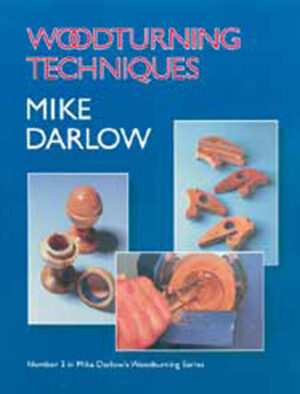WOODTURNING METHODS
$35.00
Available on back-order
by Mike Darlow
Softcover
215 x 280mm
194pp
Published by The Melaleuca Press, Lot 17 Wilsons Lane, Exeter
ISBN 0-9589609-2-5
As reviewed in The Australian Woodworker Issue 90
This is a guest review by Dale Hageman, a professional turner working out of Erskineville, and part-time woodturning teacher at Lidcome College of TAFE. He studied under George Hatfield and John Ewart at the Sydney Technical College from 1979-1982, and worked for a number of companies around town before starting out on his own in 1995.
Woodturning Methods is the second book in Mike Darlow’s woodturning series, following The Fundamentals of Woodturning. It is a meaty text – 200 pages long and printed in full-colour – with about 500 photographs, drawings and reproductions of historic engravings.
The opening chapter covers the history of chucking. It also details almost every modern chucking method, a number of which you can make yourself. It concludes with vacuum chucking.
Eight different special methods of spindle turning are described in Chapter 2, including sizing, cutting pommels, captive and loose rings, and turning trees. The theme of spindles is continued in the next chapter, on slender turning. This features a comprehensive section on lathe steadies.
Sphere turning is made easy through the descriptions provided on twelve techniques covered by Darlow, in a section devoted to teaching the ins and outs of this particular turning challenge.
Two chapters exclusively on eccentric and multi-axis turning will reveal many alternative methods that – I suspect – will be new to many readers. Elliptical turning, an area which only a minority will be able or willing to attempt, is covered well. Readers will find the subject interesting, particularly as it is becoming more accessible through the releases of John Rea’s elliptical chuck and other similar devices, as well as the expected release later this year of the Volmer elliptical lathe. The book closes with a comprehensive summary of drilling on the lathe. It even shows how to easily and accurately sharpen a twist drill bit.
This is a very comprehensive text and contains a bibliography of almost all the turning books ever published in English. It includes a section on books in foreign languages, books on ornamental turning, and lists the various woodturning magazines.
Mike writes in depth, and does not shirk from including mathematics where necessary for clarity and accuracy. The maths help the reader use particular techniques efficiently.
He has written for those who want to know the complete picture, and has gone to great trouble to be clear and concise, acknowledging all his sources.
The format relies heavily on illustrations with captions, which I feel help explain the information provided. Some of the captions occupy a quarter of a page, so they are very detailed. Another feature of the book is that the works of both Australian and international turners are used to illustrate the techniques, which I found very satisfying to see.
Although I am a professional turner with over 20 years in the trade, some of the information was new to me, and therefore perhaps unnecessary in my day-to-day work. Hobbyists may also find parts of the book of no immediate relevance, though the opposite is also true. Both professionals and hobbyist will find immediate applications for many of the techniques described.
There is something we need to appreciate about Mike’s approach. He is not attempting to make everyone happy by teaching them things they already know and do. He is, by presenting information in detail and supporting it, enabling you to move your turning forward.
His writing challenges the common belief that there is nothing new in turning, and also demonstrates how much we can learn from the masters of the past. The book’s relevance to new turners is illustrated by the number of my students who have attempted the multi-axis turning of ducks and spoons, and the folded bowls.
Woodturning Methods is, unlike The Fundamentals of Woodturning, a book you can dip into to research a particular topic. It’s great to have on hand in the workshop, but will also make a fine bedside companion for all turners.
Photos: Colour
Contents
Chucking
Chucking to 1800
Chucking from 1800 to 1960
Modern Woodturning Chucking
Mounting Chucks
Homemade Chucks
Vacuum Chucking
Partial-Vacuum Chucking
Summary
Endnotes
Spindle Turning
Mounting and Demounting with the Lathe Running
Pommels
Sizing
Captive Rings
Loose Rings
Split Rings
Turning Trees
Swash Turning and Pumping
Endnotes
Slender Spindles
Modifying Tool Use
Lessening Tailstock Thrust
Optimizing the Sequence of Tool Use
Reducing Lathe Speed
Chucking the Left-Hand End
Modifying a Spindle’s Design
Steadies
Using Steadies
Turning a Long Spindle in Components
Internal Stresses in Wood
Dowelling
Rounding
Turning Trembleurs
Endnotes
Turning Spheres
The First Step
The Second Step
The Polygonal Method
Using Templates
The Polygonal Method for a Sphere on a Spindle
The Billiard-Ball Method
Turning on Two Turning-Axes with Hand Finishing
Turning on Two Turning-Axes without Hand Finishing
The Layers Method
Sphere Turners
The Tube Gouge
Turning a Hemisphere
Special Devices and Techniques
Hollowing a Hemisphere
Endnotes
Eccentric Turning
Static and Dynamic Balance
Molding an Edge
Therming
Angular Therming
Skewed Therming
Thermed Boxes
Inside-Out Turning
Assymetrical Inside-Out Turning
Endnotes
Multi-Axis Turning
Chucks for Multi-Axis Turning
Examples wirth Parallel Turning-Axes in the Same Plane}
Examples with Parallel Turning-Axes not in the Same Plane
Examples with Non-Parallel Turning-Axes in the Same Plane
Contemporary Spindles
Examples of Non-Parallel Turning-Axes Not in the Same Plane
Endnotes
Ellipitical Turning
The Ellipse
Turning Ellipses
Multi-Turning-Axis Turning
The Rose Engine
The Elliptical Chuck
The Volmer Lathe
The Elliptical Cutting Frame
Turning an Elliptical Workpiece
Dividing Ellipses
Endnotes
Drilling
Drill Types
Drill Care and Modification
Drill Sharpening
Accessories
Drilling Methods and Equipment
Long-Hole Boring
Finish-Turning After Boring
Bored, Stepped, Reamed, Tapered, and Counterbored Holes
Endnotes
Where Next?
Bibliographies
Index







